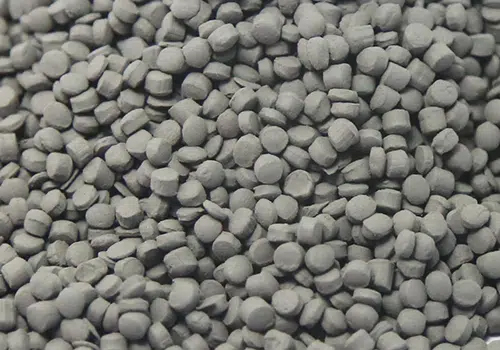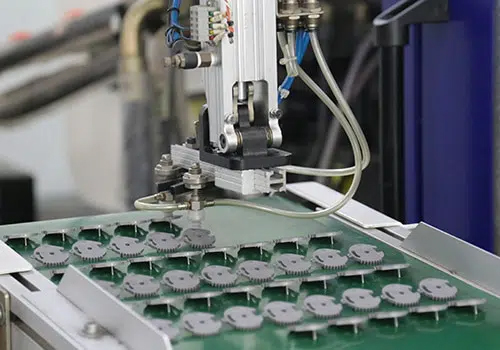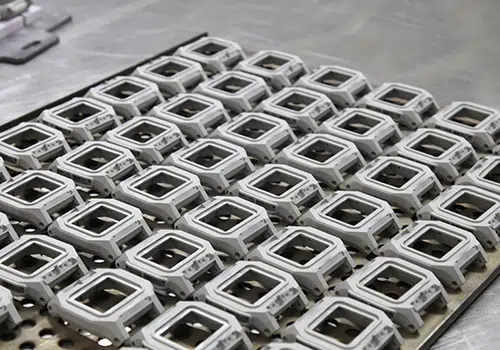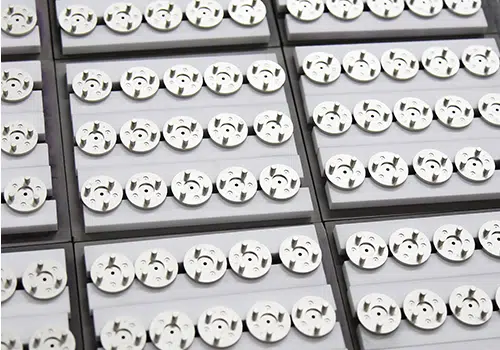Small parts with complex shapes High precision Stable performance Surface finish high productivity Raw materials can be recycled
Metal Injection Molding, also known as MIM, is an advanced metal manufacturing process that is a cost-effective method for producing metal parts with high density, complex geometry and excellent performance. A new invention in MIM manufacturing, it combines the flexibility of injection molding with the strong structural integrity of powder metal sintering. The strength, economy and capacity of complex geometry metal parts demonstrated in metal injection molding are attributes sought by customers.These advantages of MIM promote its widespread use in the electronics, medical, industrial and automotive industries.
Metal Injection Molding is a process for manufacturing metal parts with high precision and complex structures. This molding process combines metal powder, injection molding and sintering techniques to ensure that MIM parts can have precision tolerances and excellent surfaces. In addition, the selection of metal powders with different sizes and shapes and supplemental additives will produce different chemical and physical properties of the MIM part, and the binder composition of each powder particle will determine the final shape hardness.
The BRM team will work with you to evaluate the feasibility of MIM production costs, materials and manufacturing. We will also suggest design adjustments to achieve the best results for metal injection molding.
The main steps of MIM include: mixing, injection molding, degreasing, and sintering.




Metal Injection Molding (MIM) offers several advantages over traditional metal production techniques. With 30 years of continuous development of MIM technology, BRM can apply the technology to produce MIM parts with large volumes, multiple alloys, different sizes and complex structures. Our summary of the advantages of MIM is as follows.
Design complexity | This technology allows for the production of more complex parts than other metal forming methods. You can freely add cross holes, angel holes, splines, undercuts, side holes and recesses to your part design without any limitations. In addition, MIM can create entire parts without the need for individual production and post-assembly production methods. |
Excellent performance | It can produce fully dense metal parts in a complete process close to the theoretical sintered density, so the physical and chemical properties of MIM parts are excellent. the mechanical strength of MIM parts far exceeds that of powder metallurgy, and in addition, it can be produced by MIM, but never machined from bar stock. |
Small scale | MIM technology uses very fine metal powders to produce high-density metal parts, and it is best suited for the manufacture of small parts, typically weighing between 0.1 and 250 grams. All of these parts are difficult to manufacture using conventional methods. |
Environmental Economy | The technology always uses the right amount of metal material to manufacture a defined number of MIM parts. With no material waste compared to the machining process, raw material utilization will be close to 100% and material waste will be effectively avoided. |
Robust capacity | MIM is the most cost-effective process for manufacturing metal parts, with a flexible capacity that can be adjusted from hundreds to millions per day. |
High tolerances | MIM sintering can achieve high tolerances of ±0.5% for dimensional tolerances and ±0.3% for target tolerances. Combining MIM with other machining methods will improve dimensional accuracy. |
Flexible materials | Metal injection molding technology can be applied to most metal materials. Considering the special properties and economics of metals, our main application materials include: iron, steel, nickel, copper, titanium and alloys. |
Exquisite appearance | The sintered surface toughness of up to 1 μm is ideal for further surface treatment and gives an excellent dazzling appearance. |
Various applications | MIM technology can meet a variety of applications in different industries. Its high quality ensures a wide range of applications in environments with corrosion resistance, high strength and tolerances. |
Various metal materials can be used in the MIM process. Metal powders with various chemical compositions, particle sizes and shapes will determine the final performance of MIM parts.BRM main MIM metal materials are classified as follows.
Ferroalloys: steel, stainless steel, tool steel, low alloy steel, iron-nickel alloys, special iron alloys such as Yin steel and Koval iron-nickel-cobalt alloy.
Tungsten alloy: tungsten copper, tungsten heavy alloy.
Nickel alloys: Nickel, nickel-based high-temperature alloys.
Molybdenum alloy: molybdenum, molybdenum copper.
Titanium alloy: titanium, titanium alloy
Hard materials: cobalt-chromium, cemented carbide (WC-Co), cermet (Fe-TiC)
Special materials: aluminum, precious metals, copper and copper alloys, cobalt-based alloys, magnetic alloys (soft and hard), shape memory alloys
Material | Density | Tensile strength | Hardness | Elongation | |
g/cm3 | Mpa | Rockwell | (%in 25.4mm) | ||
Stainless steel | 316L | ≥7.85 | ≥450 | 100-150 HV10 | ≥40% |
304 | ≥7.75 | ≥480 | 100-150 HV10 | ≥40% | |
420 | ≥7.55 | ≥750 | 30~39 HRC | ≥1% | |
440C | ≥7.5 | ≥700 | 30~39 HRC | ≥1% | |
17-4ph(Sintered) | ≥7.65 | ≥950 | 25~30 HRC | ≥3% | |
17-4ph(Heat treatment) | ≥7.7 | ≥1100 | 35~40 HRC | ≥9% | |
P.A.N.A.C.E.A. | ≥7.5 | ≥1090 | 270~300 HV10 | ≥35% | |
Low alloy steel | 4605 | ≥7.5 | ≥600 | 90 HV10 | ≥5% |
Fe02Ni | ≥7.55 | ≥260 | 90 HV10 | ≥3% | |
Fe04Ni | ≥7.6 | ≥630 | 90 HV10 | ≥3% | |
Fe08Ni | ≥7.65 | ≥630 | 90 HV10 | ≥3% | |
Fe03Si | ≥7.55 | ≥227 | 100~180 HV10 | ≥24% | |
Fe50Ni | ≥7.85 | ≥468 | 110~180 HV10 | <1% | |
Fe50Co | ≥7.5 | ≥300 | 80 HRB | ≥20% | |
Special material | Copper | ≥8.5 | ≥180 | 35~45 HRB | ≥30% |
Ti-6AI-4V | ≥4.5 | ≥950 | 36 HRC | ≥35% | |
Nickel alloy | ≥8.6 | - | 63 HRC | - | |
ASTM F15 | ≥7.7 | ≥450 | 65 HRB | ≥25% | |
ASTM F75 | ≥8.3 | ≥992 | 25 HRC | ≥30% | |
ASTM F1537 | ≥8.3 | ≥1103 | 32 HRC | ≥27% | |
Most alloy compositions are copied from standard manual formulations, but it cannot be overlooked that prolonged annealing during the sintering process can degrade alloy properties, as most alloys are created and developed in the casting technique. Therefore, BRM utilizes modified chemistry in MIM technology to ensure the physical and chemical properties of MIM parts.
For example, the 316L alloy composition (Fe-19Cr-9NI-2Mo) is widely used due to its corrosion resistance and combined strength properties. The additional chromium in the alloy composition will make the sintering process easy, so this alloy offers excellent properties obtainable through this alternative metal manufacturing method.
Once the composition is not available, custom metal powders can be manufactured at an additional cost. There is no doubt that BRM will meet any of your custom material requirements at the most cost effective price.
Our MIM (Metal Injection Molding) parts tolerances are stated as ±0.3% to 0.5%, and we can provide tighter tolerances through our quality management if deemed necessary for special accuracy requirements.
Because MIM components are often produced over a wide range, it is difficult to address tolerances directly.BRM has created a list of tolerances and dimensions in MIM part manufacturing, as follows
±0.03 mm (for features up to 3 mm) |
±0.05 mm (for features between 3 mm and 6 mm) |
±0.08 mm (for features between 6 and 15 mm) |
±0.15 mm (for features between 15 and 30 mm) |
±0.25 mm (for features between 30 and 60 mm) |
In addition, for the various features in MIM parts, BRM provides a list of tolerances for customer reference.
Feature | Nominal or Typical ± | Best possible ± |
Absolute dimension | 0.025 mm | 0.05 mm |
Angle | 0.05° | 2° |
Density | 0.2% | 1% |
Dimension | 0.05% | 0.3% |
Flatness | 0.1% | 0.2% |
Hole diameter | 0.04% | 0.1% |
Hole location | 0.1% | 0.3% |
Parallelism | 0.2% | 0.3% |
Perpendicularity | 0.1% or 0.1° | 0.2% or 0.3° |
Roundness | 0.3% | 0.3% |
Surface roughness | 0.2 µm | 0.8 µm |
Weight | 0.1% | 0.4% |
Corner radius | 0.1 mm | 0.15 mm |
Metal Injection Molding (MIM) combines two custom manufacturing techniques: plastic injection molding and powder metallurgy, together to produce MIM parts with complex 3D geometries. It is the most effective method for producing high-density parts with mechanical properties comparable to those of the original metal material. In addition, it provides greater design freedom and opportunities for innovation in the development of MIM products. zCMM parts have important applications in a wide range of industries. Products that are best suited for MIM typically have the following characteristics.
Complexity: MIM allows a high degree of design freedom, which creates virtually unlimited shape capabilities. mim can combine individual parts into multifunctional components at no additional cost. There is no doubt that our MIM can be easily adapted to any product.
Accuracy: The net shape accuracy of MIM parts is ±0.5% in size and ±0.3% for certain features. For high tolerances, various MIM finishing processes can be achieved at a much higher cost.
Weight and size: MIM is suitable for parts less than 100 grams, less than 50 grams is the most economical application, we can also produce parts weighing up to 250 grams. Raw materials are key to MIM cost control, so we can use coring and ribs to reduce product weight without compromising product integrity. mim part sizes up to 250mm in length with no limitations.
Section thickness: Wall sections less than 6mm are best suited for the MIM process. Thicker sections will increase costs due to longer processing times and additional material. MIM can manufacture thin sections less than 0.5mm, depending on your design requirements.
Production volume: Our MIM is a scaled-up process from 1000 to millions of pieces per year with an economical schedule.
Application assistance: BRM will provide the most comprehensive assistance to our customers to realize the value of MIM. We will help you in product development with product design, material selection, failure effect analysis, rapid prototyping and laser scanning.
Contact: Alexander Sun
Phone: +86 19916725893
Tel: 0512-55128901
Email: [email protected]
Add: No.6 Huxiang Road, Kunshan development Zone, JiangsuShanghai Branch: No. 398 Guiyang Rd, Yangpu District, Shanghai, China